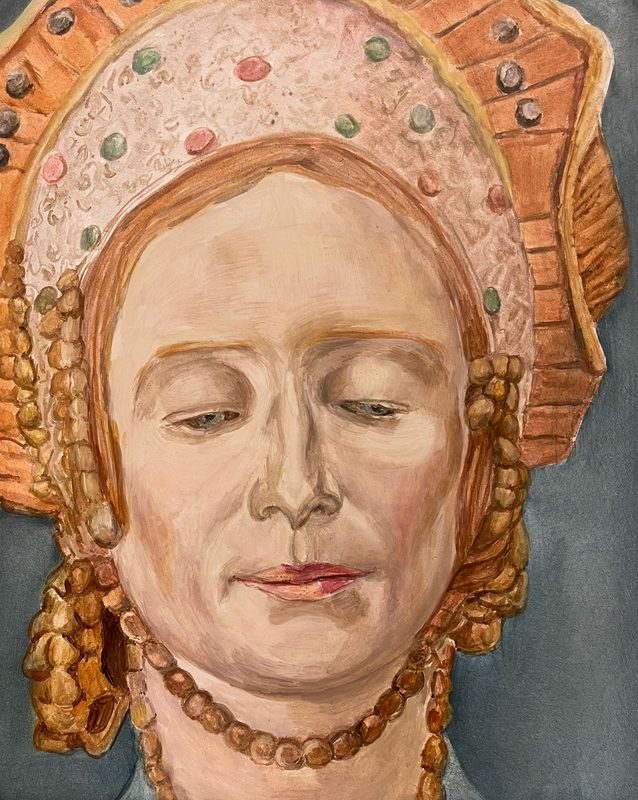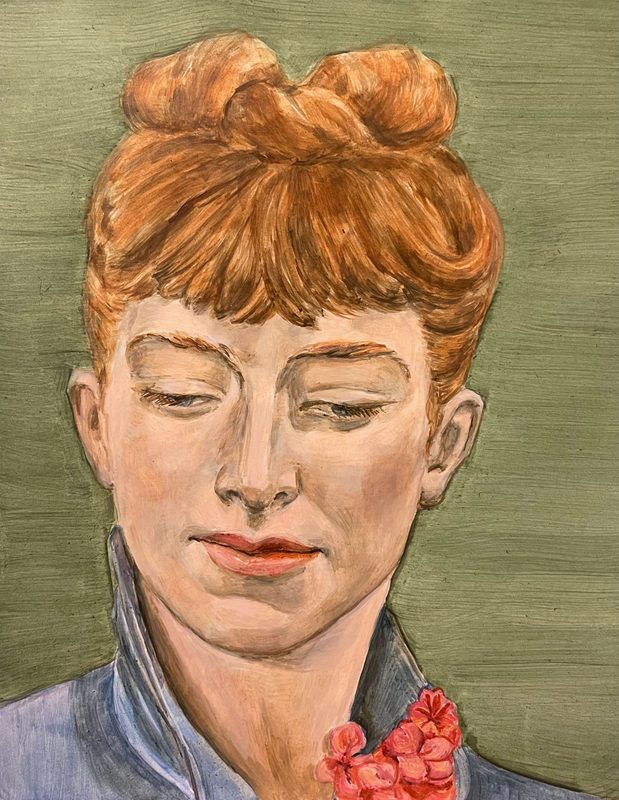In my recent post on Gwen John I mentioned that it was unfortunate that for many years she was thought of as one of Rodin's models rather than as an artist in her own right. Just a few days later I'm reminded of this by an exhibition that focuses on Rodin's relationship with other women in his life. There is an exhibition on at the Henry Moore Centre in Leeds that is of interest to painting, drawing, sculpture and installation practitioners. Rebecca Fortnum has managed to bring all these practices together into a small one room exhibition that demonstrates how sharply focused research can be used to drive work forward. It is also a good example of how to curate a small space and with final shows on the horizon, it would be useful to go and see this exhibition if only to assess how well it uses the available space.
Rebecca Fortnum, 'Les Praticiennes (Bernhardt, Louise)' 2022, oil on gesso board. Painting based on original work by Sarah Bernhardt, 'Louise Abbéma' 1878, marble, Musée D’Orsay, Paris.
The cross fertilisation of different aspects of practice is fascinating. First of all we have Fortnum's paintings based on photographs of sculptures. All the paintings are made at a similar size and orientation, so that they fit neatly into a grid of images. The original subjects would have been sculptures made by the women that Fortnum has researched. These sculptures would have been photographed at the time using black and white film, then these images would have been rediscovered later either as original photographic images or as black and white prints of them in a book. Fortnum then makes paintings of the faces of these sculptures working from the photographs, adding colour as she does so. Therefore sculpture, photography and painting are fused together as Fortnum seeks to infuse life back into these images, in many ways making these women come back alive to us by infusing the whole of one wall of the exhibition with colour.
On the adjacent wall are large framed black and white drawings made from the faces of the sculptures these women worked on, most of which are of course men. These images are larger, organised in a more organic presentation and are made of a rich black chalk on paper. Thus making this wall more imposing, especially as these men mainly look directly out at you, rather than turning their gaze inwards.
On a third wall is one large black chalk drawing of a full length statue; Bessie Vonnoh’s Sarah Bernhardt. This single image in many ways sums up the issues Fortnum is presenting. Vonnoh is presented as an artist who is capable of making full length sculptural portraits, Bernhardt is presented as a significant woman of her time and by Fortnum isolating the drawing, we are asked to think about this image's double significance.
Rebecca Fortnum was a recent artist researcher in residence at the Henry Moore centre and had used her time as a researcher to follow the lives of women who had worked with Rodin during the time of his fame, either as studio assistants or as participants in his art classes.
Rodin devoted significant time to teaching women to sculpt, as well as employing them as studio assistants. At that time, other artists seldom worked with women and for the most part, women working in sculpture in turn-of-the-century Paris encountered demeaning prejudice. What Fortnum found was that all of Rodin’s female assistants had extraordinary and in most cases unpublished, life narratives and she decided to therefore make a body of work to remedy this.
Fortnum selected sculptural works by twelve women who she had researched and found to be not just associated with Rodin’s studio, but who were making sculptures in their own right. She has made portrait paintings from their work, and has exhibited these paintings against hand designed wallpaper, the paintings forming a regular rectangle set out against the wallpaper's gradually graded pink patterned surface. These images of women often have their eyes closed or downcast, reflecting either an inner spiritual life or a certain modesty that was expected of women at the time.
“In my selection these women are depicting women (often a friend or peer) with their eyes downcast or closed, looking away. I enjoy the ambiguity implicit in both the signalling of empowered absorption or self-containment alongside a reading of social conformity and female modesty. The viewer may decide which.” - Rebecca Fortnum
The most intense image that sits within the 'male' wall is that drawn from Camille Claudel's Bust of Rodin. His beard is rather like a force of nature, cascading down like a waterfall, a sign of his male virility. This intensity I imagine is part and parcel of what Fortnum is trying to represent, the 'heroic' stance expected from romanticised male artists being perhaps as much as a trap as the demure downward cast stances of the women depicted, both men and women trapped within the expectations of their time and society. The rewriting of history is however always just that, it doesn't change what actually happened, it can only be for the future. By seeing the past for what it was we hopefully don't make the same traps for ourselves again, but as Margaret Atwood pointed out, 'Men are afraid that women will laugh at them. Women are afraid that men will kill them.'
Camille Claudel: Bust of Rodin
Rebecca Fortnum, 'Les Praticiennes (Warrick Fuller, Maxwell)' 2022, carbon pencil on paper. Drawing based on original work by Meta Vaux Warrick Fuller, 'Poet (Portrait of Maxwell Nicy Hayson)' c. 1920s, painted plaster
Rebecca Fortnum, 'Bessie Vonnoh’s Sarah Bernhardt' 2022, Carbon pencil on paper.
Sarah Bernhardt (1844-1923)
Kühne Beveridge (1879-1944)
Camille Claudel (1864-1943)
Hilda Flodin (1877-1958)
Sigrid af Forselles (1860-1935)
Meta Vaux Warrick Fuller (1877-1968)
Anna Golubkina (1864-1927)
Malvina Hoffman (1885-1966)
Madeleine Jouvray (1862-1935)
Jessie Lipscomb (1861-1952)
Clara Rilke-Westhoff (1878-1954)
Bessie Potter Vonnoh (1872-1955)
Ottilie Maclaren Wallace (1875-1947)
Emilie Jenny Weyl (1855-1934)
Enid Yandell (1869-1934)
See also:
Whether or not to use theory Rebecca Fortnum approaches her research from a standpoint within Feminist Theory. The exhibition is a clear example of how research can drive practice, but how do you decide what sort of theory to use as a support for research?
Rebecca Fortnum: 'Les Praticiennes' A link to the Henry Moore Centre with details of when the exhibition is on and opening times.





No comments:
Post a Comment